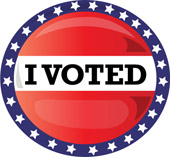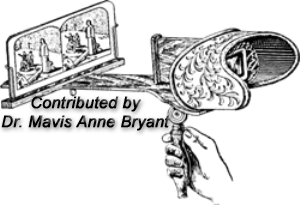Grayson
County TXGenWeb

Sunday
Gazetteer
June 21, 1908
A COLORED BOSS
In
early days when voting qualifications were
not hedged in by the
Australian ballot, Terrell law, etc., the
colored voter cut a big
figure in local political affairs, in
fact, if a solid colored vote, or
even 75 per cent of that vote could be
controlled, it meant victory to
a candidate. In those days many
colored voters were counted that
resided in the Indian Territory and the
outskirts. The sanctity
of the ballot was not considered.
The colored boss was much in
evidence, and he made a good thing at
politics. The boss was a
colored barber name Dave Williams, and he
paid more attention to
politics than he did to shaving of
people. Dave conducted a
swell barber shop and he numbered among
his patrons all of the
politicians, big or little. They
found it to their advantage to
stand in with Dave in the political
shuffle, in fact, Dave carried the
colored vote in his breeches pocket and
wielded an influence in
politics that turned the scale in many an
election in the 70s.
Dave was a wire puller. He
could make a nice calculation as
to how many votes he could deliver, but of
course, the political
machinery had to be greased, and Dave made
more money at politics than
running a barber shop. He was a
smooth talker, a good dresser,
and well posted; he was magnetic, and the
average Negro fell into
Dave's way of thinking and voted
accordingly.
Several
colored political bosses attempted to
unhorse Dave, but he put them all
to rout. This man's influence in
local politics had to be
reckoned with, and for years he was a
power that no seeker of office
could afford to ignore.
Times
changed and the election laws became more
stringent. Men who
lived in the Indian Territory and Arkansas
could not have a vice in our
city affairs. Then Dave as a
political boss, commenced to
decline. When a Negro presented
himself at the polls he had to
prove up his right to vote. Still
the influence of Dave Williams
was paramount for a long period, and until
he left here the colored
people looked up to him as a sort of Moses
to whom they could go for
advice.
He is at
present conducting a barber shop in the
City of Mexico.
African-American
Williams of Denison, Texas
| 1876-1877 |
David
Williams (colored) has a barber shop,
"Williams and Son," at 207-1/2 W.
Main St. Large advertisement in City
Directory: "Fashionable
Tonsorial Artists. Hair cutting,
shampooing, and shaving done
with neatness and dispatch. Bath rooms
attached." Working
as barbers at this shop, too, are Horace G.
Williams and James
Williams, both colored. David Williams
also owns a saloon on the
south side of Woodard between Austin &
Houston avenues. He
resides on the north side of Bond between
Burnett and Rusk avenues. |
| 1889-1890 |
D.
[David} W. Williams (colored,) barber &
bath rooms, 218 W. Main St.
Residence at the same place.
Quarter-page ad: "Williams'
Shaving Parlor, 218 West Main St., Denison,
Texas. Hot & cold
baths. D.W. Williams, Proprietor." |
| 1889-1890 |
Laura J. Williams (colored), works
at D.W. Williams; resides at the same place |
| 1889-1890 |
James
Williams (not designated as colored) is a
laborer at the Ice Factory.
He lives on Johnson St. between Travis
& Crockett avenues. |
| 1891 |
The Sunday Gazetteer
Sunday,
January 4, 1891
pg. 4
EMANCIPATION DINNER
Dave
Williams, the colored barber at No.
220 Main street, celebrated New
Year by giving an emancipation dinner
to which were invited a number of
the more prominent colored men of the
city. Mayor Tone, Hon. A.B.
Person and W.S. Pearson were present
as orators of the occasion.
Mr. Person counseled the colored
people to a higher and better
life, stating that he had fought hard
to keep them in slavery, but now
he would fight equally as hard to keep
them out. The mayor
congratulated them, as a race, on the
progress made during the last 25
years and hoped they would continue.
Mr. Pearson told them
that when a small boy he used to eat
pot liquor from a wooden bowl with
his father's slaves in southwest
Georgia, and that his first horse-back
ride was behind "old Uncle Pete," on
the wheel-mule hitched to a wagon
loaded with cotton for the Columbus
market. He told them that he
was glad slavery existed when it did
and as it did, but was now glad of
their freedom. On the Negroes of
the South rested the great
responsibility of redeeming
Africa. England, Germany,
France,
Portugal and Austria had made an
inglorious failure, and that the life
work of the American Negroes for ages
to come should be the abolition
of the slave trade, and then the
Christianizing and civilizing of the
dark men on the dark continent.
He counseled them to habits of
industry, sobriety, cleanliness and
honesty, and above all things to
preserve their self-respect, letting
politics severely alone.
Marked attention were paid the
speakers, and many thanks were
expressed for their presence.
|
| 1893-1894 |
David W. Williams (colored) is a
barber at 218 W. Main St.; he lives at that
address, too. |
| 1893-1894 |
Thompson
& Williams barber shop (colored) is at
106 N. Rusk Ave.
Principals are Joseph Thompson
(colored), who lives at 305
W. Bond St.; and Peter Williams
(colored), residing at 522 N.
Houston Ave. |
| 1893-1894 |
Working
at the Columbia Restaurant, 209 W. Main St.
upstairs, is Alfred
Williams (colored). He boards at 612
N. Mirick Ave.
Also boarding there is Elbert Williams
(colored) |
| 1896 |
"Pete
Williams. Everything first-class in
the tonsorial line.
Hot Baths & Warm Rooms. Ford
Building." (Source:
Program, Denison Opera House, November 19,
1896) |
| 1896-1897 |
To
judge from City Directory information,
several "colored" barbers seem
to have had close relationships with Levi B.
Burton and Edward D.
Burton. Living next door to Levi
Burton at 615 N. Mirick Ave. is
Harry Platt, who works at 307 W. Main St.
Peter Williams, who
operates a barber shop at 106 N. Rusk Ave.,
lives at 522 N. Houston
Ave. Sherley O. Platt works at Peter
Williams' barber shop &
resides at 527 W. Bond St. |
| 1896-1897 |
Carlisle
& Williams Restaurant, 205 N. Houston
Ave. Grant Carlisle
(colored) and (who?), proprietors. The
business is also described
as a lunch room |
| 1898-1899 |
The
Palace Barber Shop (colored) is at
109-1/2 E. Main St.
Proprietor is Edward D. Gentry
(colored), who lives at 627 W.
Bond St. Also working there as barbers
are Sylvester Lott
(colored), who resides with his wife
Virginia at 100 W. Bond St.; Peter
Williams (colored), perhaps also an owner
of the shop, who
lives with his wife Eleanor at 423 W.
Walker; and Sherley O. Platt
(colored), living at 527 W. Bond St. |
| 1898-1899 |
Another
Palace Barber Shop is at 106 N. Rusk Ave.
(106 Ford Building).
Proprietor is Peter Williams
(colored). He resides at 423
W. Walker St. |
| 1899-1900 |
C.F.
Williams (colored) is a barber at Love &
Haywood barber shop
(colored), 121 W. Main St. Principals
are James S. Love &
S.H. Haywood. Williams is married
& living at 116 W. Walker
St. |
| 1899-1900 |
The
Palace Barber Shop (colored) is at 106 N.
Rusk Ave. (106 Ford
Building). Principals are Peter
Williams (colored), married &
living at 423 W. Walker St.; & Sylvester
Lott (colored), married
& living at 408 W. Johnson St. |
| 1908 |
David Williams "At present
conducting a barber shop in the City of
Mexico." (Source: Sunday Gazetteer, June 21,
1908.] |
| 1915 |
"Pete
Williams. Hair cut, shampoo &
massage. Best Barbers in
the City." [Source: The DHS Yellow
Jacket, 1915] |
[Source : City
Directories]

|



